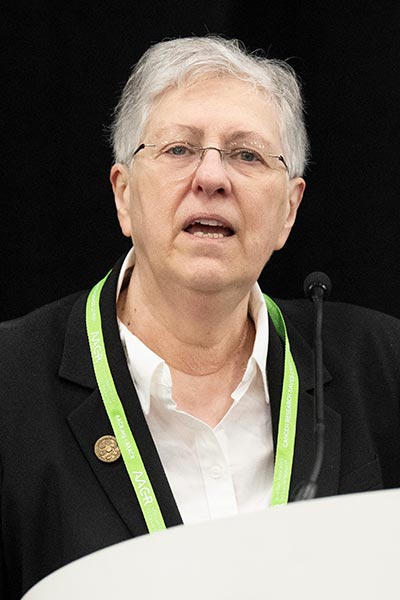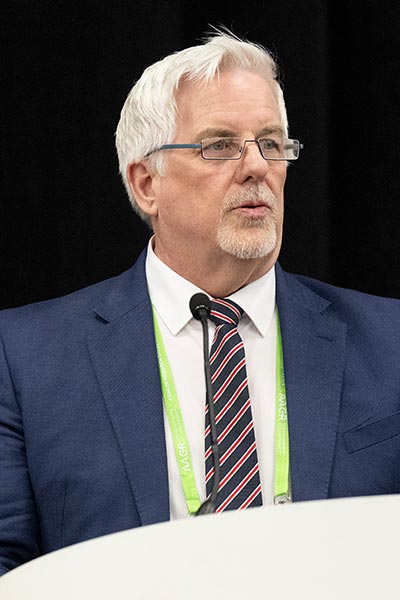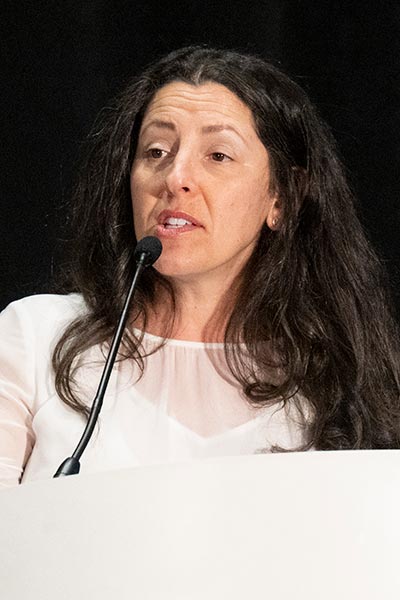Presidential Address examines the necessary puzzle pieces to realize the promise of personalized medicine
Prior to her tenure as President of the American Association for Cancer Research (AACR) coming to end at the AACR Annual Meeting 2025, Patricia M. LoRusso, DO, PhD (hc), FAACR, delivered the Presidential Address about one of her greatest passions: oncology drug development.

LoRusso, now the AACR Immediate Past President, has held roles in drug development for much of her career, including in her current position as the chief of the Early Phase Clinical Trials Program at Yale Cancer Center. In her talk, From Hierarchical Molecular Composition to Transforming Oncology Drug Development, she described the history of drug development and discussed where she hopes it is headed.
She began with the story of how Louis S. Goodman, MD, and Alfred Gilman, PhD, FAACR, used nitrogen mustard in 1942 to treat a patient with non-Hodgkin lymphoma to demonstrate for the first time that chemotherapy could kill cancer cells. But back then, she explained, drugs were mostly discovered because of circumstance.
For most of the ’70s and ’80s, new U.S. Food and Drug Administration approvals for cancer drugs remained stagnant. But the late ’90s to early 2000s saw a robust increase in approvals for cancer treatments, which LoRusso attributed to the National Cancer Institute funding researchers interested in investigating the biology of the disease.
New understandings behind the mechanisms of cancer have led to many advances since then—including immunotherapy, targeted therapy, and even drugging the once-considered-undruggable KRAS—but LoRusso is most interested in what’s next for personalized medicine.
The pieces needed to advance personalized medicine
“In terms of personalized medicine, we’ve only just begun,” LoRusso explained, further describing our current state as “personalized medicine 101.” She offered an analogy of a puzzle where each piece represented a different area of research that would be crucial to build the complete picture needed to realize the promise of personalized medicine.
The first piece she discussed was genomics. While the identification of oncogenes has informed new targeted therapies, those treatments often have durability issues as patients’ tumors develop resistance.
“Is targeting genomics going to be good enough for personalized medicine? I personally don’t think so,” LoRusso said. “It is going to be one of our tools, but we need an armamentarium.”
One of those other needed tools is transcriptomics. As James E. Darnell Jr., MD, FAACR, pointed out in 2002, there are only a few dozen transcription factors compared to hundreds of genes that are altered in cancer. LoRusso said this perhaps makes transcription factors a better target for anticancer drugs while potentially helping to inform ways to overcome mechanisms of resistance.
For the next puzzle piece, immunomics, LoRusso acknowledged how immune checkpoint inhibitors have been the “glory drugs of the 21st century,” but she is again looking to what is next—targeting genome stability. Encouraging results in relation to that concept were presented at this meeting. The Werner helicase (WRN) is an enzyme that when inhibited can disrupt genome stability. A phase I clinical trial for a WRN helicase inhibitor enrolled 44 patients with microsatellite instable and/or mismatch repair deficient advanced solid tumors who were previously treated with a median of three immune checkpoint inhibitors before disease progression. The disease control rate for the 35 efficacy-evaluable patients treated with the WRN helicase inhibitor was 65.7%, which LoRusso said shows the potential of this target to help develop more durable treatments.
Proteomics will be another crucial piece. LoRusso specifically touched on the power of phosphoproteomics. While genomics and transcriptomics offer information on what LoRusso described as the “instructions of the tumor,” phosphoproteomics could take things a step further with insights into the working machinery of the disease that could identify potential proteins worth targeting.
“Theoretical [at the moment], I hope one day we will be able to execute it in my lifetime,” LoRusso said.
Among the other important pieces LoRusso mentioned were epigenetics, spatial biology, functional data, metabolomics, and the microbiome.
“What we need to do is bring this information together—bring all of these puzzle pieces together in an integrated advanced computational analysis and modeling format, so that we can truly personalize medicine for our patients,” she said.
Making strides against cancer on a global scale

Ultimately, LoRusso hopes the information gained from each of these areas can inform not only treatment strategies but also ways to advance prevention and interception for all patients.
“The global cancer burden is horrific,” she said, adding that worldwide, 1 in 5 people develop cancer in their lifetime.

That’s why LoRusso focused another session she helped develop, the Presidential Select Symposium, on her other passion: global health. LoRusso and the chair of that session, Robert Bristow, MD, PhD, of the University of Manchester, selected a panel of eight experts to discuss Leveraging Science to Reduce the Cancer Burden Worldwide.
The panelists spoke about cancer research being conducted in other countries—including Costa Rica, Malawi, Malaysia, Australia, Kenya, and India—as well as the perspective of the World Health Organization (WHO).
Among the work presented were the recently unblinded results from the ESCUDDO trial, which compared one versus two doses of an HPV vaccine in lowering the incidence of HPV16/18 persistent infection in 20,330 girls between ages 12 and 16 in Costa Rica.

Aimée R. Kreimer, PhD, of the National Cancer Institute, presented the potential practice-changing results that indicated one dose was no less effective than two doses in protecting against HPV16/18 infection, with either dosage resulting in at least 97% vaccine efficacy.
“A lot of countries with very large birth cohorts of girls still have yet to introduce HPV vaccination,” she explained. “A global single-dose HPV recommendation should facilitate country introductions and vaccine uptake.”
LoRusso said that the work being done by Kreimer and the rest of the members of the panel illustrated the importance of global research to the people in those countries as well as the ability of the knowledge gained to benefit patients all around the world.
The recordings of both sessions are available for registered Annual Meeting attendees through October 2025 on the virtual meeting platform.
More from the AACR Annual Meeting 2025
View a photo gallery of scenes from Chicago, continue the conversation on social media using the hashtag #AACR25, and read more coverage in AACR Annual Meeting News.

